*THE FIGHT OR FLIGHT RESPONSE has got a new name. It's now called the fight, flight or freeze response. Stress experts around the world are adding the word freeze to the name in deference to the fact that instead of fighting or fleeing, sometimes we tend to freeze (like a deer in the headlights) in traumatic situations.
The fight or flight response (in its original form) is about survival. It's about hope. We activate it when we believe there's a chance we can outrun or outfight our attackers. The freeze response however, gets activated when's there's no hope.
In some respects, this response.....
continue reading at: *http://www.stressstop.com/stress-tips/articles/fight-flight-or-freeze-response-to-stress.php
**Fight-or-flight response
From Wikipedia, the free encyclopedia
For other uses, see Fight or Flight.
The fight-or-flight response (also called the fight, flight, freeze, or fawn response in post-traumatic stress disorder, hyperarousal, or the acute stress response) is a physiological reaction that occurs in response to a perceived harmful event, attack, or threat to survival.[1]It was first described by Walter Bradford Cannon.[a][2] His theory states that animals react to threats with a general discharge of thesympathetic nervous system, priming the animal for fighting or fleeing.[3] More specifically, the adrenal medulla produces a hormonal cascade that results in the secretion of catecholamines, especially norepinephrine and epinephrine.[4] The hormones estrogen,testosterone and cortisol, and the neurotransmitters dopamine and serotonin, also affect how organisms react to stress.[5]
This response is recognized as the first stage of the General Adaptation Syndrome that regulates stress responses among vertebratesand other organisms.[6]
continue reading at: **https://en.wikipedia.org/wiki/Fight-or-flight_response
***The USGS Water Science School
The water in you: USGS HomeContact USGSSearch USGS
Think of what you need to survive, really just survive. Food? Water? Air? Facebook? Naturally, I'm going to concentrate on water here. Water is of major importance to all living things; in some organisms, up to 90% of their body weight comes from water. Up to 60% of the human adult body is water.
According to H.H. Mitchell, Journal of Biological Chemistry 158, the brain and heart are composed of 73% water, and the lungs are about 83% water. The skin contains 64% water, muscles and kidneys are 79%, and even the bones are watery: 31%.
Each day humans must consume a certain amount of water to survive. Of course, this varies according to age and gender, and also by where someone lives. Generally, an adult male needs about 3 liters per day while an adult female needs about 2.2 liters per day. Some of this water is gotten in food.
Water serves a number of essential functions to keep us all going:
- A vital nutrient to the life of every cell, acts first as a building material.
- It regulates our internal body temperature by sweating and respiration
- The carbohydrates and proteins that our bodies use as food are metabolized and transported by water in the bloodstream;
- It assists in flushing waste mainly through urination
- acts as a shock absorber for brain, spinal cord, and fetus
- forms saliva
- lubricates joints
According to Dr. Jeffrey Utz, Neuroscience, pediatrics, Allegheny University, different people have different percentages of their bodies made up of water. Babies have the most, being born at about 78%. By one year of age, that amount drops to about 65%. In adult men, about 60% of their bodies are water. However, fat tissue does not have as much water as lean tissue. In adult women, fat makes up more of the body than men, so they have about 55% of their bodies made of water. Thus:
- Babies and kids have more water (as a percentage) than adults.
- Women have less water than men (as a percentage).
- People with more fatty tissue have less water than people with less fatty tissue (as a percentage).
There just wouldn't be any you, me, or Fido the dog without the existence of an ample liquid water supply on Earth. The unique qualities and properties of water are what make it so important and basic to life. The cells in our bodies are full of water. The excellent ability of water to dissolve so many substances allows our cells to use valuable nutrients, minerals, and chemicals in biological processes.
Water's "stickiness" (from surface tension) plays a part in our body's ability to transport these materials all through ourselves. The carbohydrates and proteins that our bodies use as food are metabolized and transported by water in the bloodstream. No less important is the ability of water to transport waste material out of our bodies.
***URL: http://water.usgs.gov/edu/propertyyou.html
Page Contact Information: Howard PerlmanPage Last Modified: Wednesday, 09-Dec-2015 12:59:33 EST
courtesy of: ***http://water.usgs.gov/edu/propertyyou.html



No comments:
Post a Comment